Dogs
Are Peanuts Safe for Dogs? Essential Guide
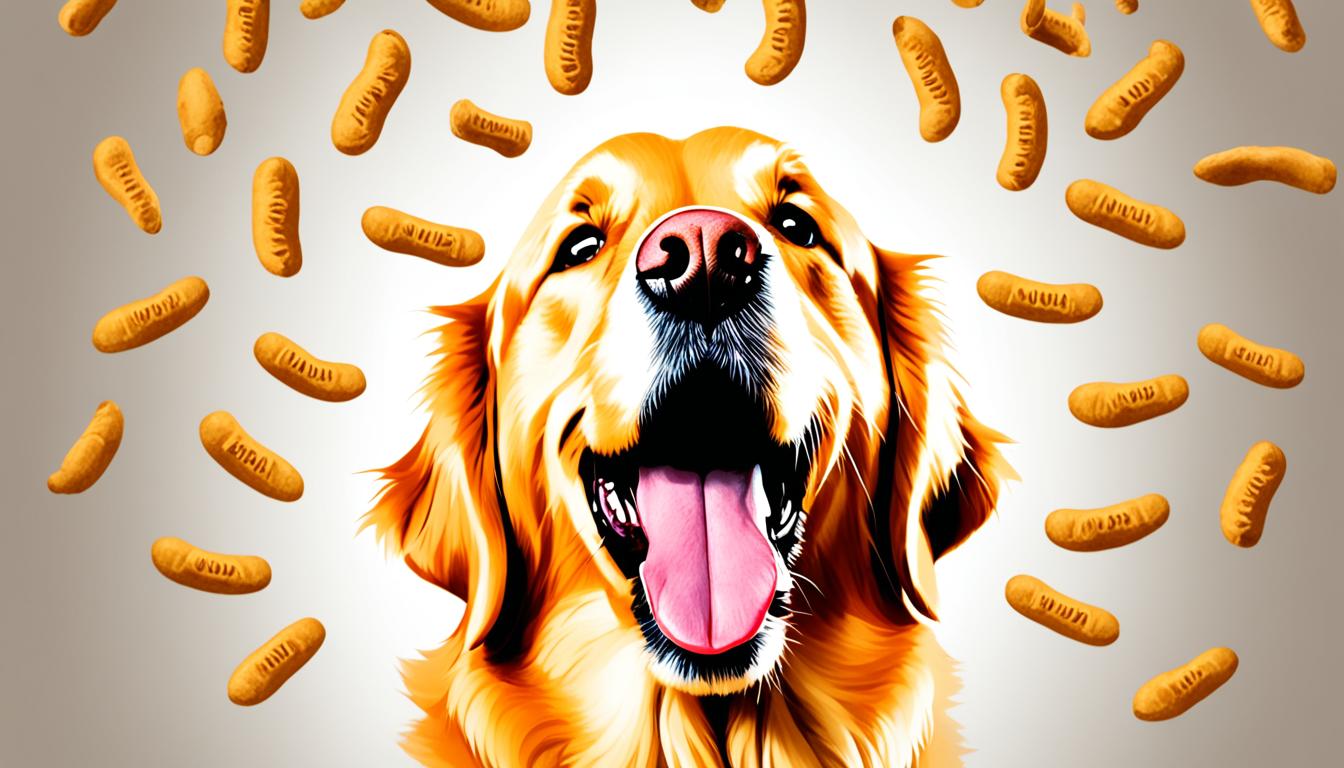
Did you know that peanuts are a common treat given to dogs by many owners? While they may seem harmless, it’s important to understand whether peanuts are safe for dogs or if they pose any risks. This article will delve into the topic to help you make informed decisions about feeding peanuts to your furry friend.
Key Takeaways:
- Peanuts can provide valuable nutrients to dogs, but they should only make up a small portion of their daily caloric intake.
- Allergies to peanuts can occur in dogs and may present with symptoms such as trouble breathing and swelling.
- The high fat content in peanuts can lead to digestion problems and pancreatitis in dogs.
- Choose unsalted peanuts or roasted peanuts without any added flavorings when feeding them to your dog.
- Some peanut butter brands may contain xylitol, a sweetener that is highly toxic to dogs. Always check the ingredients before giving your dog peanut butter.
The Nutritional Value of Peanuts for Dogs
Peanuts offer a host of nutritional benefits for dogs, packed with essential vitamins and minerals that contribute to their overall health and well-being. These nutrient-rich legumes can provide a valuable addition to your furry friend’s diet when given in moderation.
When it comes to vitamins, peanuts contain a good amount of vitamin B6, which aids in healthy brain development and promotes a strong immune system. Vitamin E is also present, serving as a potent antioxidant that helps protect cells from damage caused by free radicals.
Minerals found in peanuts, such as phosphorus, potassium, and niacin, further enhance the nutritional profile. Phosphorus supports healthy bones and teeth, while potassium helps maintain proper muscle function and nerve communication. Niacin, on the other hand, plays a critical role in energy production and cell metabolism.
It is important to note that while peanuts are beneficial for dogs, they should only make up a small portion of their daily caloric intake. Typically, peanuts should account for no more than 10% of a dog’s daily diet to prevent overconsumption and maintain a balanced nutritional intake.
Incorporating peanuts into your dog’s diet can be a nutritious way to provide them with essential vitamins and minerals. However, it’s always wise to consult with your veterinarian before making any significant changes to your furry friend’s dietary routine.
Summary: Nutritional Benefits of Peanuts for Dogs
To summarize, peanuts offer the following nutritional benefits for dogs:
- Valuable vitamins, including vitamin B6, which supports brain development, and vitamin E, an antioxidant that protects cells.
- Essential minerals such as phosphorus, potassium, and niacin that contribute to bone health, muscle function, and energy production.
- Peanuts should be given in moderation and make up no more than 10% of a dog’s daily caloric intake.
By incorporating peanuts into your dog’s diet responsibly, you can provide them with a wholesome snack that contributes to their overall well-being and nutritional needs.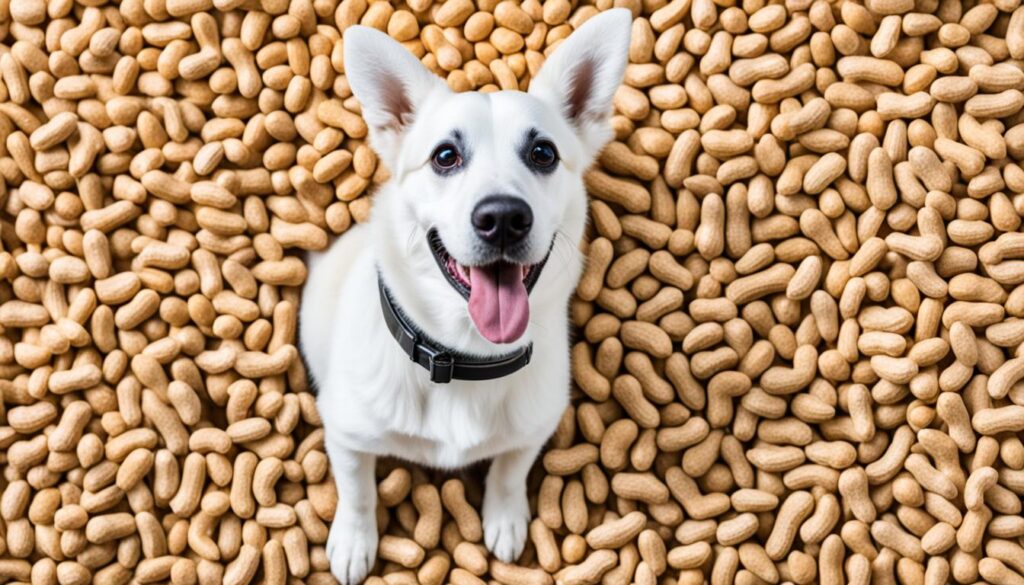
Potential Risks of Feeding Peanuts to Dogs
While peanuts can offer nutritional benefits, they also come with potential risks for dogs. It’s important for dog owners to be aware of these risks to ensure the well-being of their furry friends.
Allergic Reactions: Peanut Allergy in Dogs
Just like humans, dogs can develop allergies to peanuts. An allergic reaction to peanuts can range from mild symptoms, such as itching or skin irritation, to more severe reactions, including difficulty breathing, swelling, or even anaphylaxis. If your dog shows any signs of an allergic reaction after consuming peanuts, it’s vital to seek immediate veterinary assistance. Avoid feeding peanuts to dogs known to have a peanut allergy.
Digestion Problems: Digestion Problems from Peanuts in Dogs
The high fat content in peanuts can pose digestion problems for dogs. Consuming large amounts of peanuts or peanut butter can lead to gastrointestinal issues such as stomach upset, diarrhea, or vomiting. Dogs with sensitive stomachs or those prone to digestive problems should be given peanuts in limited quantities or avoid them altogether.
Pancreatitis: Pancreatitis in Dogs
The rich fat content in peanuts can also increase the risk of pancreatitis in dogs. Pancreatitis is a painful condition characterized by inflammation of the pancreas. Symptoms of pancreatitis in dogs may include loss of appetite, abdominal pain, vomiting, and diarrhea. If you suspect your dog has pancreatitis, prompt veterinary care is essential to prevent complications and ensure a speedy recovery.
It’s crucial to monitor your dog’s response to peanuts and consult with a veterinarian if you have any concerns. Every dog is unique, and what may be safe for one dog may not be suitable for another. Understanding and managing the potential risks associated with feeding peanuts to dogs is vital to keep them safe and healthy.
Choosing the Right Peanuts for Dogs
When it comes to feeding peanuts to dogs, it’s important to choose the right type. Different varieties of peanuts can have different effects on a dog’s health. Here’s a guide to selecting the best peanuts for your furry friend:
Unsalted Peanuts for Dogs
Unsalted peanuts are the safest option when it comes to feeding dogs. Excessive sodium can be harmful to dogs and can lead to various health issues. By opting for unsalted peanuts, you can eliminate the risk of sodium overload in your dog’s diet.
Boiled Peanuts for Dogs
In some regions, boiled peanuts are a popular snack. If you want to share this treat with your dog, it’s essential to ensure that the peanuts are unsalted and unseasoned. Dogs can enjoy boiled peanuts in small quantities, as long as they are free from any additional flavors or spices.
Roasted Peanuts for Dogs
Roasted peanuts are generally safe for dogs. However, it’s important to choose plain roasted peanuts without any added flavors or seasonings. Flavored varieties like honey-roasted or spiced peanuts should be avoided as they often contain ingredients that may be harmful to dogs.
| Type of Peanuts | Safety for Dogs | Precautions |
|---|---|---|
| Unsalted Peanuts | Safe | Ensure absence of added salt |
| Boiled Peanuts | Safe in moderation | Choose unsalted and unseasoned peanuts |
| Roasted Peanuts | Safe in moderation | Avoid flavored or seasoned varieties |
It’s crucial to remove the shells from peanuts before feeding them to your dog. The shells can pose a choking hazard and should not be ingested. By following these guidelines and making informed choices, you can ensure that your dog enjoys the benefits of peanuts without any potential risks.
Peanut Butter for Dogs
Peanut butter is undoubtedly a favorite treat among canines, providing a tasty and satisfying indulgence. However, not all peanut butter is safe for our furry friends. When selecting peanut butter for your dog, it’s essential to consider their health and ensure that the product is suitable for their consumption.

The Importance of Choosing the Right Peanut Butter
While peanut butter can be a nutritious addition to a dog’s diet, it’s crucial to opt for safe options and avoid potential risks. Here are some key considerations:
- Check for Unsalted Peanut Butter: Excessive sodium consumption can be harmful to dogs. Therefore, it’s recommended to choose unsalted peanut butter to control their salt intake.
- Avoid Added Sugars: Sugar-free peanut butter is a prudent choice to prevent the potential dangers of added sugars in a dog’s diet. Too much sugar can contribute to obesity, diabetes, and dental problems in dogs.
- Be Wary of Xylitol: Some peanut butter products may contain xylitol, a sweetener that is highly toxic to dogs. Xylitol ingestion can lead to a severe drop in blood sugar levels, liver failure, and even death. Carefully read the ingredient list and avoid peanut butter that contains xylitol.
Homemade Peanut Butter for Dogs
For those who prefer a more hands-on approach, making homemade peanut butter can provide peace of mind, knowing exactly what goes into the treat. Here’s a simple recipe:
“Homemade Peanut Butter Recipe”
- Ingredients:
- 2 cups unsalted peanuts
- Instructions:
- 1. Preheat oven to 350°F (175°C).
- 2. Spread the peanuts on a baking sheet in a single layer.
- 3. Roast the peanuts in the oven for 10-15 minutes, or until golden brown.
- 4. Remove the peanuts from the oven and let them cool.
- 5. Place the cooled peanuts in a food processor or blender.
- 6. Pulse the peanuts until they reach a smooth and creamy consistency, scraping down the sides as needed.
- 7. Transfer the homemade peanut butter to a jar and store it in the refrigerator.
Summary
When it comes to peanut butter for dogs, it’s crucial to prioritize their safety and well-being. Opting for unsalted and sugar-free peanut butter while avoiding xylitol-containing products can help ensure their health. If in doubt, consult with a veterinarian to determine the best options for your canine companion’s dietary needs.
Peanut Butter and Jelly for Dogs
While peanut butter is generally safe for dogs, it’s important to exercise caution when it comes to peanut butter and jelly sandwiches. Can dogs eat peanut butter and jelly? Let’s find out.
Grapes, including grape jelly, are toxic to dogs and should be avoided. The risks of grape jelly for dogs can be severe, leading to kidney failure and other serious health issues. It’s best to keep grapes and grape products, including jelly, away from your canine companion’s diet.
Besides the dangers of grapes, some jellies may contain xylitol as a sweetener. Xylitol is highly dangerous for dogs and can cause a sudden drop in blood sugar levels, leading to seizures, liver damage, and even death. Therefore, it is crucial to read the labels carefully before giving your dog any jelly products.
To ensure the safety of your furry friend, it’s best to stick to plain peanut butter without any jelly. Homemade peanut butter, without additives or sweeteners, is usually the safest option. Remember to always consult your veterinarian for guidance regarding your dog’s specific dietary needs.
The Risks of Grape Jelly for Dogs:
“Grapes and grape products, including grape jelly, are toxic to dogs and can lead to kidney failure. It’s crucial to keep these foods away from your four-legged companion’s reach.”
– Dr. Jane Peterson, Veterinarian
Can Dogs Eat Peanut Butter and Jelly?
| Peanut Butter | Jelly | Safe for Dogs |
|---|---|---|
| Plain peanut butter without additives | Avoid grape jelly | Yes |
| Peanut butter with xylitol | Jelly products containing xylitol | No |
When offering peanut butter to your furry friend, it’s essential to ensure it is free from harmful ingredients like xylitol and grapes. Remember, the safety and well-being of your dog should always be a top priority.
Image:
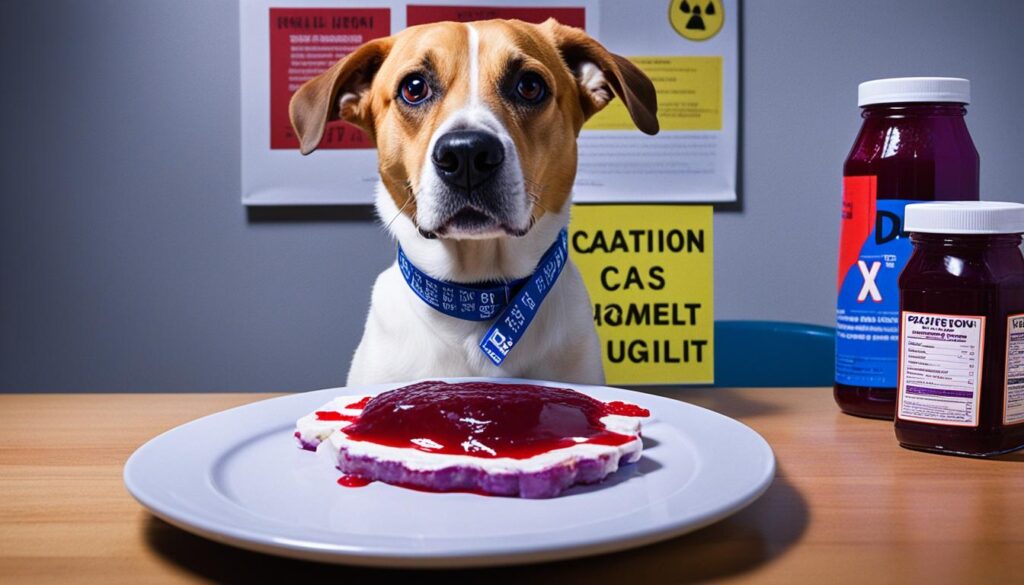
Moderation and Other Considerations
Moderation is key when it comes to feeding peanuts to dogs. While peanuts can provide valuable nutrients, it’s important to remember that they should only be given in moderate amounts. Feeding only a few peanuts occasionally and avoiding excessive intake is crucial to prevent any potential health issues that may arise from overconsumption.
It’s worth noting that dogs with certain health conditions should avoid peanuts altogether. Dogs with heart disease, kidney issues, or those on specific diets may be more susceptible to adverse effects from peanuts. It’s always best to consult with a veterinarian before incorporating peanuts into the diet of a dog with these health concerns.
Homemade Treats for Dogs
If you prefer to make treats for your dog, homemade options can be a great choice. Homemade treats allow you to have control over the ingredients and eliminate any potential health risks associated with store-bought treats.
When making homemade treats, consider using peanut butter flavored treats with moderate peanut content. This way, you can still incorporate the flavor of peanuts without the risk of overconsumption. Additionally, you can explore other healthy ingredients to include in the treats, such as carrots, pumpkin, or apples.
“Homemade treats provide a wonderful opportunity to bond with your furry friend and ensure they’re getting wholesome, nutritious snacks.”
Remember to choose recipes that are suitable for your dog’s specific dietary needs and preferences. It’s also important to avoid using any harmful ingredients, such as chocolate or xylitol, which can be toxic to dogs.
By taking a mindful approach to peanut intake and opting for homemade treats, you can ensure that your dog enjoys safe and wholesome snacks.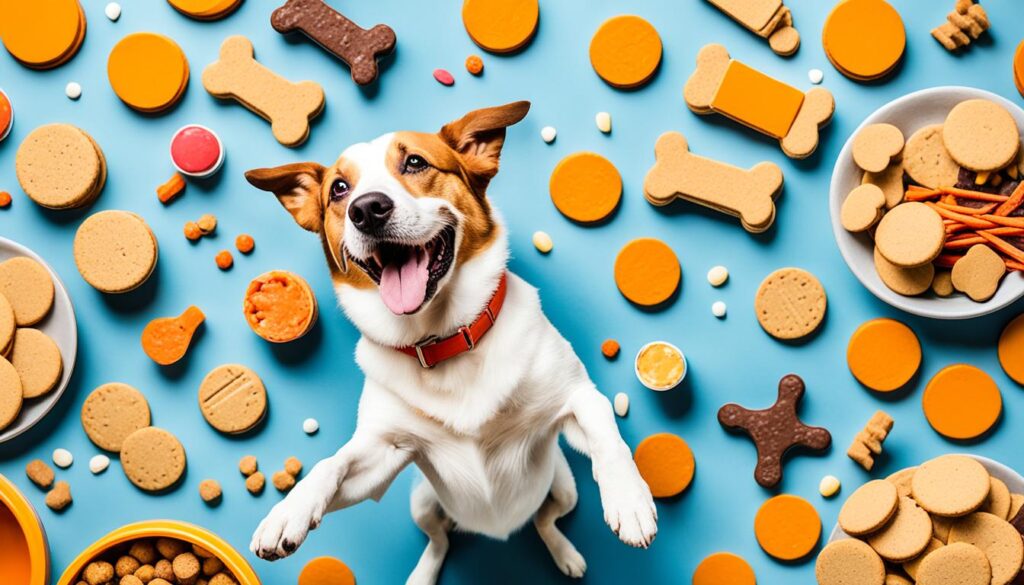
| Treat Name | Ingredients | Instructions |
|---|---|---|
| Peanut Butter Pumpkin Treats | Peanut butter, canned pumpkin, whole wheat flour, eggs | 1. Preheat oven to 350°F. 2. In a bowl, mix together peanut butter, canned pumpkin, whole wheat flour, and eggs until well combined. 3. Roll the dough into small balls and place them on a lined baking sheet. 4. Using a fork, press down on each ball to create a crisscross pattern. 5. Bake for 15-20 minutes or until the treats are golden brown. 6. Allow the treats to cool before serving to your dog. |
| Carrot Peanut Butter Bites | Carrots, peanut butter, oats, honey | 1. Grate the carrots using a box grater. 2. In a bowl, mix together grated carrots, peanut butter, oats, and honey until well combined. 3. Roll the mixture into bite-sized balls and place them on a lined baking sheet. 4. Flatten each ball using the back of a spoon. 5. Bake for 10-12 minutes or until the treats are firm. 6. Allow the treats to cool completely before serving to your dog. |
Potential Hazards of Peanuts and Nuts for Dogs
While peanuts can be safe for dogs, it’s important to be aware of the potential hazards that other nuts can pose. Some nuts can present choking hazards or even toxicity risks for our canine companions.
Choking Hazards of Nuts for Dogs
Almonds, macadamia nuts, and pecans are examples of nuts that can be potential choking hazards for dogs. Their size, shape, or hard texture can make it difficult for dogs to chew and swallow them safely. It’s crucial to prevent dogs from accessing these nuts to avoid any choking incidents.
Toxic Nuts for Dogs
When it comes to nut toxicity for dogs, macadamia nuts deserve special attention. They are known to be poisonous to dogs and can cause various symptoms when ingested. These symptoms may include vomiting, lethargy, weakness, loss of balance, and even tremors or seizures. If you suspect your dog has consumed macadamia nuts, it’s essential to seek immediate veterinary care.
Symptoms of Nut Toxicity in Dogs
The symptoms of nut toxicity in dogs may vary depending on the specific type of nuts involved. Common symptoms can include gastrointestinal issues such as vomiting or diarrhea. In more severe cases, dogs may exhibit signs of pancreatitis, which can cause abdominal pain, decreased appetite, and lethargy. If you notice any abnormalities in your dog’s behavior or health after they have potentially ingested nuts, it’s best to consult with a veterinarian for proper diagnosis and treatment.
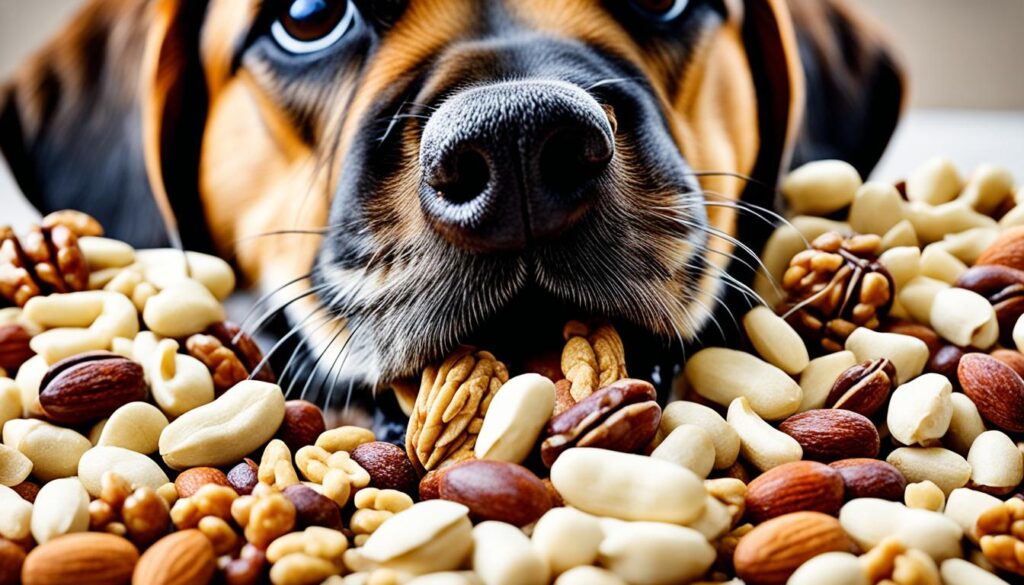
| Nut Type | Potential Hazards |
|---|---|
| Almonds | Potential choking hazards |
| Macadamia nuts | Choking hazards and toxic to dogs. Symptoms may include vomiting, weakness, and loss of balance. |
| Pecans | Potential choking hazards |
Signs of Peanut Allergy or Toxicity in Dogs
As a responsible dog owner, it’s crucial to be able to recognize the signs of peanut allergy or toxicity in your furry friend. Peanuts, although enjoyed by many dogs, can sometimes trigger allergic reactions or pose toxicity risks. By being aware of the symptoms, you can take prompt action and ensure the well-being of your canine companion.
Allergic Reactions
- Trouble breathing: Watch for signs of wheezing, coughing, or labored breathing. These could indicate an allergic reaction to peanuts.
- Swelling: Pay attention to any swelling, particularly around the face, lips, or throat. This can be a sign of an allergic response to peanuts.
- Skin reactions: Keep an eye out for itching, hives, or redness on your dog’s skin. These symptoms may also indicate a peanut allergy.
Peanut Toxicity
- Digestive issues: Vomiting, diarrhea, or abdominal discomfort can be signs of peanut toxicity in dogs. If you notice these symptoms after your dog consumes peanuts, it’s important to consult a veterinarian.
- Pancreatitis: In severe cases, excessive consumption of peanuts can lead to pancreatitis, which involves inflammation of the pancreas. Common symptoms include abdominal pain, lethargy, and loss of appetite.
- Xylitol poisoning: While not directly related to peanuts, it’s essential to be cautious when feeding peanut butter that may contain xylitol. Xylitol is a sweetener that is highly toxic to dogs. Symptoms of xylitol poisoning include vomiting, loss of coordination, and seizures.
If you observe any of these signs or suspect that your dog may have an allergy or toxicity related to peanuts, it’s crucial to seek veterinary care immediately. A professional evaluation and appropriate treatment can help ensure the well-being and safety of your beloved pet.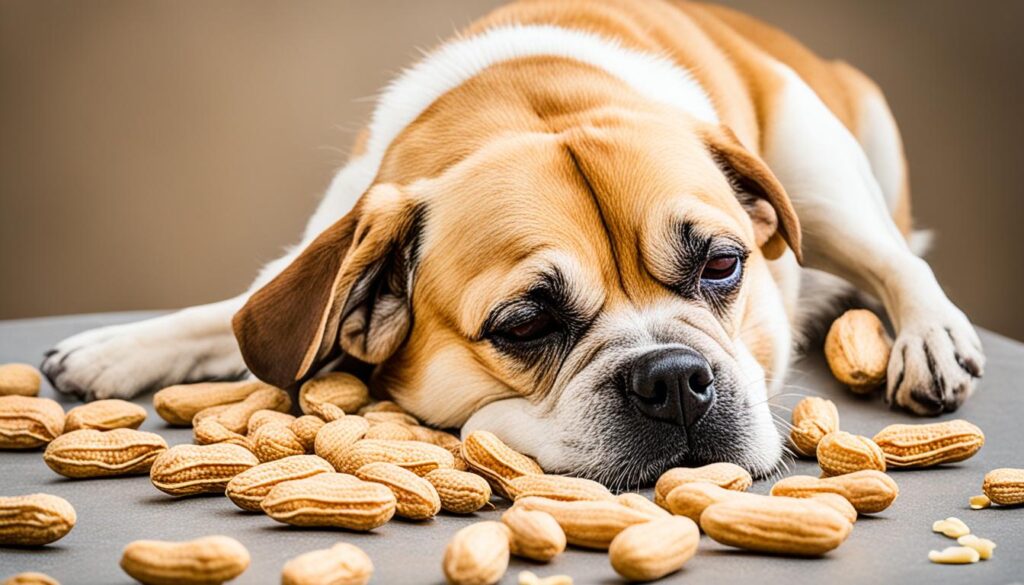
Safe Nut Alternatives for Dogs
If you’re looking for safe nut alternatives for your dog, there are several options available. Dogs can still enjoy tasty treats without the risk associated with certain nuts. Here are some alternatives to consider:
Plain Hazelnuts
Hazelnuts can be a delicious and safe nut option for dogs when given in moderation. They offer a satisfying crunch and are packed with nutrients that can benefit canine health. Just be sure to provide plain hazelnuts without any seasonings or added salt.
Roasted and Shelled Cashews
Cashews can be a nutty and nutritious alternative for dogs. They are low in cholesterol and provide essential minerals like magnesium and phosphorus. Keep in mind that cashews should be roasted and shelled to avoid any potential choking hazards.
Pine Nuts
Pine nuts can be a tasty treat for dogs when included in their diet in moderation. These small nuts have a delicate flavor and are a good source of beneficial fatty acids, vitamins, and minerals. Just remember to offer plain pine nuts without any added seasonings or spices.
Before introducing any new food to your dog’s diet, it’s always best to consult with your veterinarian. They can provide specific guidance based on your dog’s individual needs and any underlying health conditions.
If you prefer to explore ready-made options, there are also many nut-free dog treats available on the market. These treats provide a safe and delicious alternative to nuts while still satisfying your dog’s cravings for tasty snacks. Look for reputable brands that prioritize quality ingredients and meet the nutritional needs of your furry friend.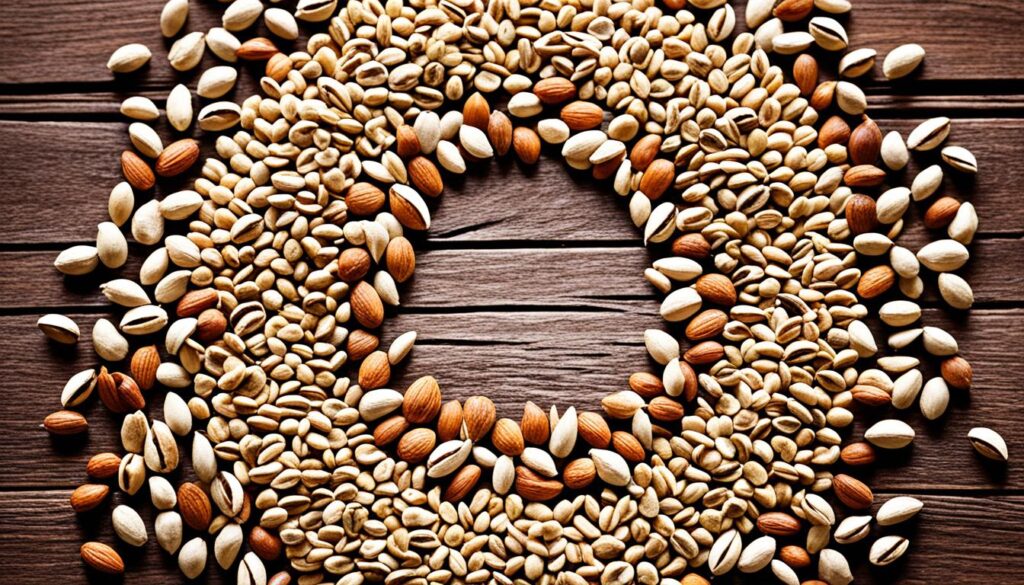
“Dogs can still enjoy tasty treats without the risk associated with certain nuts.”
Conclusion
In conclusion, the safety of peanuts for dogs depends on various factors. While peanuts can be a tasty and nutritious treat when given in moderation, it’s important to consider the potential risks they may pose to your furry friend.
Feeding unsalted, plain peanuts to dogs in small quantities is generally safe. However, it’s crucial to be cautious of potential digestive problems, pancreatitis, and allergic reactions that can arise from peanut consumption. Dogs with certain health conditions or those on specific diets should avoid peanuts altogether.
Consulting with a veterinarian can provide valuable guidance on whether peanuts are suitable for your dog’s individual needs. Additionally, practicing moderation and always prioritizing your dog’s health and well-being when offering treats is paramount.
Remember, there are alternative nut-free treats available on the market that can provide a safe and delicious option for your dog. By considering their dietary requirements and consulting with professionals, you can ensure your furry companion enjoys a healthy and balanced diet.FAQ
Are peanuts safe for dogs?
Is peanut butter safe for dogs?
What are the nutritional benefits of peanuts for dogs?
What are the potential risks of feeding peanuts to dogs?
How do I choose the right peanuts for dogs?
Can dogs eat peanut butter and jelly sandwiches?
How much peanut intake is considered moderate for dogs?
What are the potential hazards of peanuts and other nuts for dogs?
What are the signs of peanut allergy or toxicity in dogs?
What are safe nut alternatives for dogs?
What is the conclusion about dogs eating peanuts?
As our Editor-in-Chief, James plays a pivotal role in ensuring the quality and integrity of our content. With a keen eye for detail and a passion for storytelling, James oversees the editorial process here at A Place for Animals. With years of experience in content editing, James ensures that every piece of content meets our high standards of accuracy and clarity. Under James’ guidance, you can rest assured that the content you read is informative and impeccably crafted.
Dogs
Unique J.R.R. Tolkien Cat Names
Discover unique J.R.R. Tolkien cat names starting with the letter 'P', each holding a mysterious and enchanting allure for your feline companion.
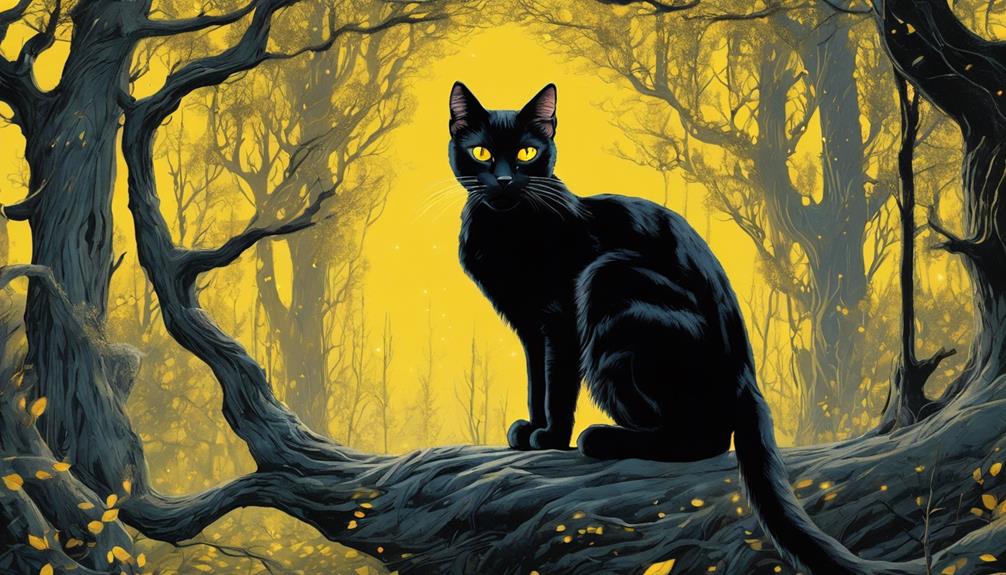
When searching for unique J.R.R. Tolkien cat names, consider iconic characters like Frodo, Gandalf, Arwen, or Legolas for traits of bravery, wisdom, grace, and skill. Explore mystical domains such as Rivendell, Lothlórien, Mordor, or Rohan, each embodying different essences from Middle-earth. Discover artifact-inspired names like One Ring, Sting, or Andúril, each with a tale from Tolkien's mythos. Reflect admirable qualities with names like Noble, Wise, Curious, Resilient, or Brave to deepen your bond with your pet. Embrace names like Sauron, Sam, Merry, or Legolas to infuse a touch of Tolkien's mythical world. Uncover more enchanting options within Tolkien's domain.
Key Takeaways
- Iconic Character Cat Names inspired by Tolkien's characters.
- Mystical Locale Cat Names reflecting Middle-earth's essence.
- Artifact-Inspired Cat Names embodying Tolkien's mythology.
- Qualities-Inspired Cat Names celebrating heroic virtues.
- Mythical Nature Cat Names inspired by Tolkien's mythical world.
Iconic Character Cat Names
When choosing unique cat names inspired by J.R.R. Tolkien's iconic characters, we can draw inspiration from the courageous and mystical beings that populate Middle-earth. Frodo, a name evoking bravery and resilience, could suit a cat with a bold spirit. Gandalf, symbolizing wisdom and guidance, might be perfect for a feline companion who exudes intelligence. Arwen, reflecting grace and sacrifice, could be a fitting choice for a gentle and loving cat. Legolas, representing agility and skill, could be ideal for a nimble and playful kitty.
Each of these names carries a rich history and deep meaning, adding a touch of magic and mystique to your cat's identity. Whether your feline friend embodies the adventurous spirit of Frodo, the wise demeanor of Gandalf, the loving nature of Arwen, or the agile movements of Legolas, choosing a name inspired by these iconic Tolkien characters can bring an extra layer of enchantment to your bond with your cat.
Mystical Locale Cat Names

Let's explore enchanting options for cat names inspired by mystical locales in J.R.R. Tolkien's Middle-earth.
For a feline companion exuding peace and wisdom, 'Rivendell' could be a perfect fit, paying homage to the tranquil elven haven where the Fellowship sought respite and counsel.
If you seek a name that captures beauty and magic, 'Lothlórien' might be ideal, reminiscent of the enchanted forest dominion ruled by Galadriel and Celeborn.
However, for a cat with a mysterious and dark allure, 'Mordor' could be a striking choice, reflecting the desolate land where Mount Doom harbored the One Ring's fiery forge.
On the other hand, if your furry friend embodies strength and nobility, 'Rohan' could be a fitting option, symbolizing the domain of the horse-lords known for their vast grasslands and skilled cavalry.
Each of these names carries a unique essence inspired by the mystical locales of Middle-earth, adding a touch of magic to your feline companion's identity.
Artifact-Inspired Cat Names
Inspiring feline names can be drawn from powerful artifacts in J.R.R. Tolkien's Middle-earth, each imbued with significant meaning and lore. For cat names inspired by rings, consider naming your furry friend after the 'One Ring,' a symbol of power and corruption sought by Sauron to dominate Middle-earth. Another option could be 'Sting,' the glowing sword wielded by Bilbo and Frodo that warns of the presence of orcs and goblins. If you seek a regal name for your cat, 'Andúril' might be a fitting choice, symbolizing Aragorn's rightful claim to the throne as the reforged sword of kings.
Each of these artifact-inspired cat names carries a unique story and essence from Tolkien's rich mythology. Whether you choose a name like the One Ring for a mischievous cat, Sting for a vigilant and adventurous feline, or Andúril for a majestic and noble companion, your cat will surely embody the spirit of these iconic artifacts from Middle-earth.
Qualities-Inspired Cat Names

Drawing inspiration from the admirable and heroic qualities depicted in J.R.R. Tolkien's works, consider naming your feline companion after virtues like 'Noble,' 'Wise,' 'Curious,' 'Resilient,' or 'Brave.' These qualities aren't only celebrated in the legendary characters of Middle Earth but also serve as a reminder of the values and traits upheld in Tolkien's masterpieces. By choosing qualities-inspired names for your cat, you can infuse depth and significance into the bond between you and your pet, reflecting the essence of Tolkien's storytelling.
Imagine calling your cat 'Noble,' embodying the dignity and honor found in characters like Aragorn or Galadriel. 'Wise' could be a fitting name for a clever and perceptive feline reminiscent of Gandalf. 'Curious' might suit a playful and inquisitive cat akin to the Hobbits exploring the Shire. 'Resilient' could be perfect for a tough and enduring companion inspired by the perseverance of Frodo. 'Brave' encapsulates the courage and valor seen in heroes like Samwise Gamgee. Choose a name that not only sounds delightful but also encapsulates the essence of the qualities you admire in Tolkien's rich tapestry of characters.
Mythical Nature Cat Names
Mythical nature cat names from J.R.R. Tolkien's works offer a blend of mystique and character for feline companions.
Sauron, a dark and powerful antagonist, lends an air of mystery and strength to your cat's persona.
Sam, embodying loyalty and bravery as a hobbit companion, provides a name full of courage and steadfastness for your furry friend.
Merry, with his cheerful and mischievous nature, offers a whimsical option that captures the playful essence of a cat.
Legolas, the skilled elven archer deeply connected to nature, bestows a name that reflects grace and agility upon your feline companion.
Each name brings a unique element inspired by Tolkien's mythical world, allowing your cat to embody traits that resonate with these iconic characters like Sauron's power, Sam's loyalty, Merry's cheer, and Legolas' connection to nature.
Choosing one of these mythical nature cat names can add a touch of magic to your feline companion's identity.
Frequently Asked Questions
What Is the Rarest Cat Name?
The rarest cat name reflects individuality and creativity. It embodies a distinctive charm that sets your feline companion apart. Discovering such a name requires thoughtfulness and a deep connection to your pet's essence.
What Is the Genius Name for Cats?
We believe the genius name for cats is one that captures their unique essence. Names like Gandalf, Arwen, Frodo, Legolas, and Sam from J.R.R. Tolkien's world offer depth and magic to our feline friends.
What Is the Name of the Royal Cat?
The name of the royal cat is Tevildo, Prince of Cats. Initially a malevolent character causing trouble for Beren and Lúthien, Tevildo eventually transformed into Sauron, showcasing Tolkien's evolving world-building in his legendarium.
Are There Any Cats in Lotr?
No, there aren't any cats in Lotr. Tolkien's world is rich with creatures, but feline friends are absent. Fans seeking Tolkien-inspired cat names will need to think beyond his works' pages.
Conclusion
To summarize, selecting a unique J.R.R. Tolkien-inspired name for your cat can infuse a sense of enchantment and playfulness into your furry companion's identity. Whether you decide on a renowned character name, a mystical place name, or a traits-inspired name, there are numerous choices available.
By thoughtfully picking a name that resonates with Tolkien's vivid imagination, you can bestow upon your cat a distinctive and unforgettable title that embodies the magical realm of Middle-earth. Choose wisely, and may your cat's name bring delight and awe to your household.
As our Editor-in-Chief, James plays a pivotal role in ensuring the quality and integrity of our content. With a keen eye for detail and a passion for storytelling, James oversees the editorial process here at A Place for Animals. With years of experience in content editing, James ensures that every piece of content meets our high standards of accuracy and clarity. Under James’ guidance, you can rest assured that the content you read is informative and impeccably crafted.
Dogs
Top 5 Cinderella-Inspired Cat Names for Royal Pets
Step into a world of enchantment with the top 5 Cinderella-inspired cat names starting with the letter 'S', fit for royal feline companions!
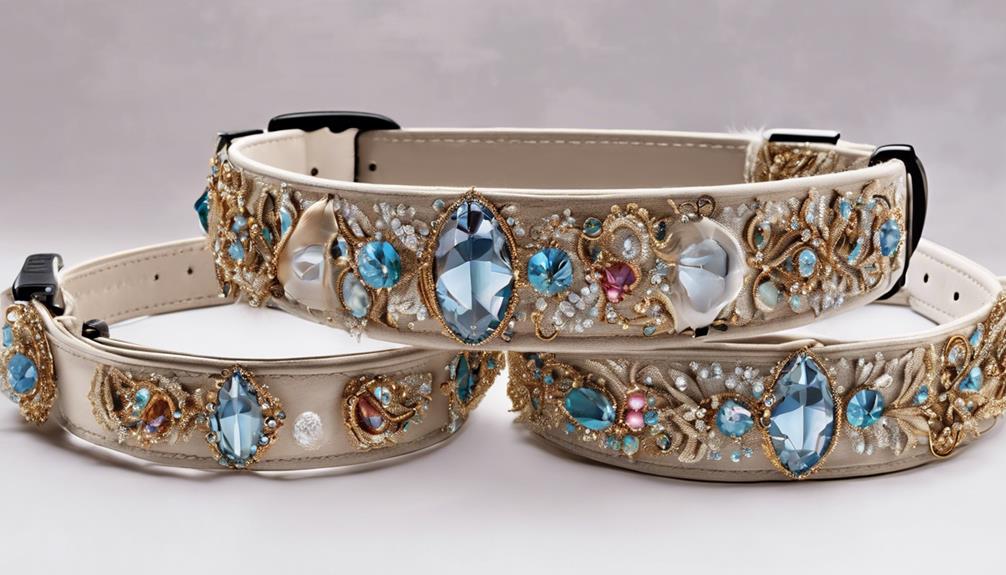
When considering names for royal feline companions inspired by Cinderella, the top five choices include Cinder, Ella, Prince Charming, Fairy Godmother, and Glass Slipper. Each name embodies regal grace, elegance, and a touch of fairy tale charm, reflecting enchantment and sophistication. Cinder symbolizes a transformative journey, Ella defines grace and elegance, Prince Charming exudes gallantry and sophistication, Fairy Godmother adds a magical touch, and Glass Slipper represents destiny fulfilled through love. These names bring a regal aura to your cat's identity, signaling nobility and charm. A royal touch awaits your feline friend with these Cinderella-inspired names!
Key Takeaways
- Cinder: embodies regal grace and charm, inspired by Cinderella's tale.
- Ella: defines grace and elegance, perfect for princess-like cats.
- Prince Charming: exudes nobility and charm, ideal for a dashing cat.
- Fairy Godmother: adds whimsy and enchantment, capturing a magical essence.
- Glass Slipper: symbolizes elegance and destiny, perfect for white cats with poise.
Cinder – A Name Fit for Royalty
Elegantly embodying regal grace and charm, our feline companion can aptly be deemed Cinder – a name inspired by the enchanting tale of Cinderella. When considering royal cat names, Cinder stands out as a classic choice that exudes fairy tale charm. This name not only pays homage to the iconic glass slipper but also symbolizes the transformative journey from rags to riches, mirroring Cinderella's story.
Choosing Cinder as a cat name for your royal pet brings a touch of magic and fantasy into your home. The name carries a sense of elegance and sophistication, fitting for a regal feline friend. Just like Cinderella captivated hearts with her grace and charm, your cat named Cinder can enchant all who encounter them. Embracing this timeless and classic name adds a touch of whimsy and enchantment to your furry companion, making them truly stand out as royalty among pets.
Ella – Graceful and Elegant Choice
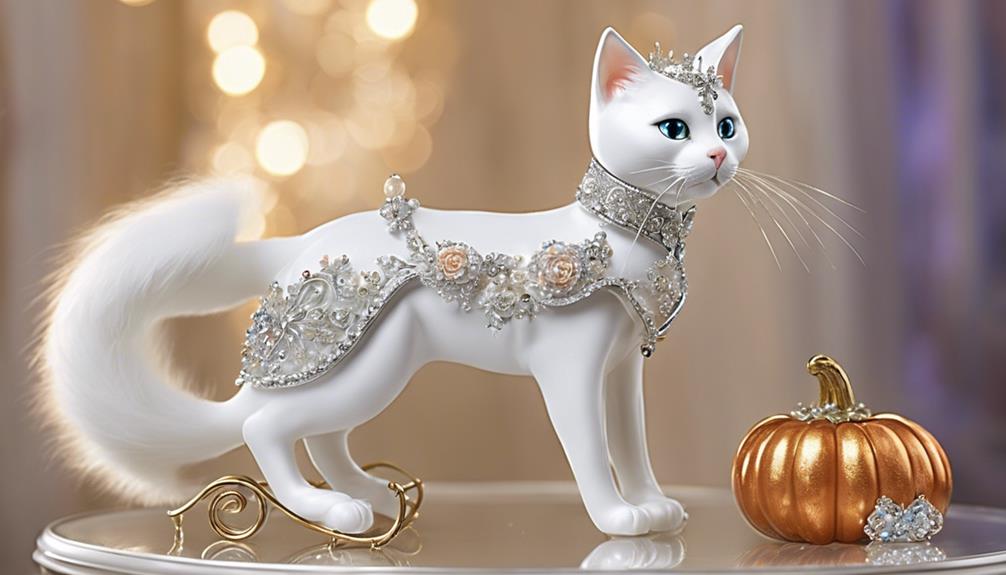
Grace and elegance define 'Ella' as a timeless and charming choice for your royal feline companion. This name exudes a sense of royalty and sophistication, perfect for a princess-like cat that embodies grace and elegance in every movement.
Just like Cinderella, 'Ella' is a name that resonates with a regal aura, making it an ideal pick for cat owners seeking a touch of fairy tale magic in their pet's identity. The simplicity and beauty of 'Ella' encapsulate the essence of a graceful and elegant companion, reflecting the poise and charm befitting a royal cat.
Choosing 'Ella' for your feline friend not only honors the beloved princess but also adds a sense of refinement and sophistication to their character. Embrace the royal heritage and noble qualities that 'Ella' brings, elevating your cat's status to that of a true princess in your household.
Prince Charming – Perfect for a Dashing Cat
A cat named Prince Charming embodies a regal and dashing presence that captures the essence of nobility and grace. This royal kitty exudes charm and elegance, making it a perfect choice for feline companions who deserve a name that reflects their majestic nature.
Prince Charming isn't just a name; it symbolizes the virtues of gallantry and sophistication, aligning perfectly with the image of a cat with a princely demeanor. The significance of the name goes beyond mere words; it signifies nobility and grace, just like a crown adorning the head of a king.
Choosing Prince Charming as the moniker for your furry friend adds a touch of fairy tale magic to their identity, elevating them to a level of enchantment and regality that suits their distinguished character. So, if you seek a name that conveys both elegance and nobility, consider Prince Charming for your beloved feline companion.
Fairy Godmother – Adding a Magical Touch
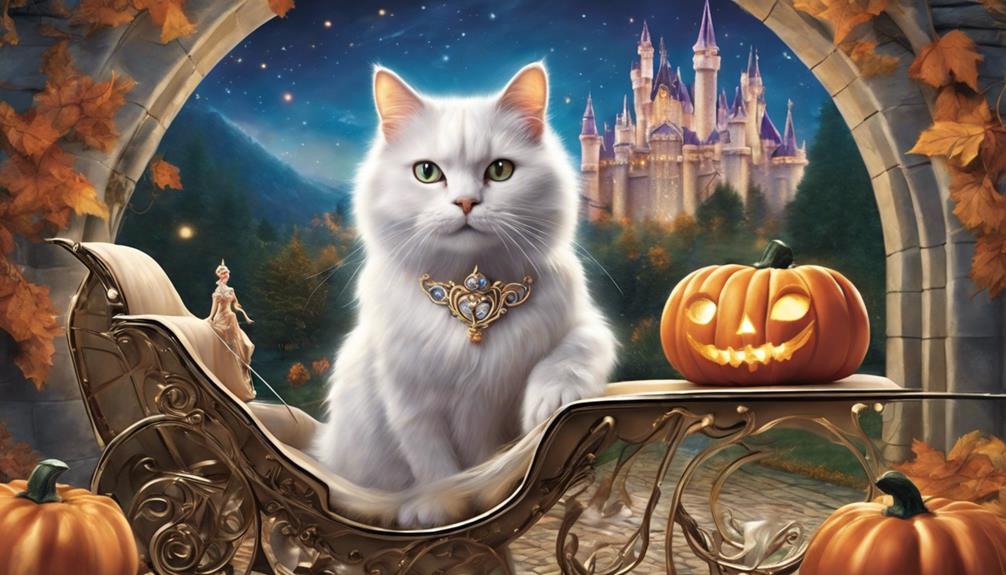
Embracing the enchanting allure of a magical touch, a Fairy Godmother-inspired name for your feline companion can infuse their persona with whimsy and charm.
The Fairy Godmother, known for her transformative magic in the Cinderella story, brings a sense of enchantment to any royal pet lucky enough to bear her name. Names like 'Fae' or 'Glimmer' capture the mystical essence associated with the fairy godmother, adding a touch of fantasy to your cat's identity.
Imagine your regal pet embodying the same spellbinding abilities as the enchanting Fairy Godmother. Choosing a name like 'Enchanta' or 'Charisma' can evoke the transformative magic she wields, creating a sense of wonder and elegance around your furry friend.
Glass Slipper – Symbol of Elegance
Infusing your feline companion's persona with elegance and charm, the Glass Slipper serves as a symbolic representation of grace and enchantment in the Cinderella story. This magical shoe, with its ability to fit only Cinderella's foot, signifies not just a perfect fit but also destiny fulfilled through love.
For a white cat exuding regal poise and sophistication, 'Glass Slipper' could be the perfect name, embodying the essence of royalty and elegance. Just like in the fairy tale, where the glass slipper is the key to identifying Cinderella as the true princess, naming your royal pet after this iconic symbol means capturing the enchanting and magical aura of the Cinderella tale.
The Glass Slipper symbolizes the transformative power of love and destiny, making it an ideal choice for a cat that exudes grace and charm. So, if you have a white cat that embodies elegance, consider 'Glass Slipper' as the perfect regal name.
Frequently Asked Questions
What Is a Royal Name for a Cat?
We believe a royal name for a cat embodies elegance and nobility, often inspired by monarchs, historical figures, or fictional characters. Such names add sophistication to a pet's identity, creating a regal aura.
What Cats Are Royal?
We believe that various cat breeds can be considered royal based on their regal appearance, demeanor, or historical associations. Some feline companions of monarchs or nobles receive special treatment, titles, and roles in royal households.
What Disney Name Should I Name My Cat?
We should name our cat after a beloved Disney character! It's a tough decision, but Cinderella, Gus-Gus, Anastasia, Jaq, or Fairy Godmother are all enchanting choices for our royal feline friend.
What Are Disney Cats Called?
We call them Disney cats, those charismatic felines that weave mischief and charm into our beloved stories. Whether heroes or villains, they captivate us with their antics, adding depth and whimsy to the tales we adore.
Conclusion
So there you have it, the top 5 Cinderella-inspired cat names fit for your royal feline companion. Whether you choose Cinder, Ella, Prince Charming, Fairy Godmother, or Glass Slipper, your cat will surely feel like a true prince or princess.
These names not only capture the essence of the beloved fairy tale, but also add a touch of elegance and magic to your pet's identity. Choose wisely and watch your cat reign supreme in their kingdom!
As our Editor-in-Chief, James plays a pivotal role in ensuring the quality and integrity of our content. With a keen eye for detail and a passion for storytelling, James oversees the editorial process here at A Place for Animals. With years of experience in content editing, James ensures that every piece of content meets our high standards of accuracy and clarity. Under James’ guidance, you can rest assured that the content you read is informative and impeccably crafted.
Dogs
Understanding Cordyline Toxicity in Dogs
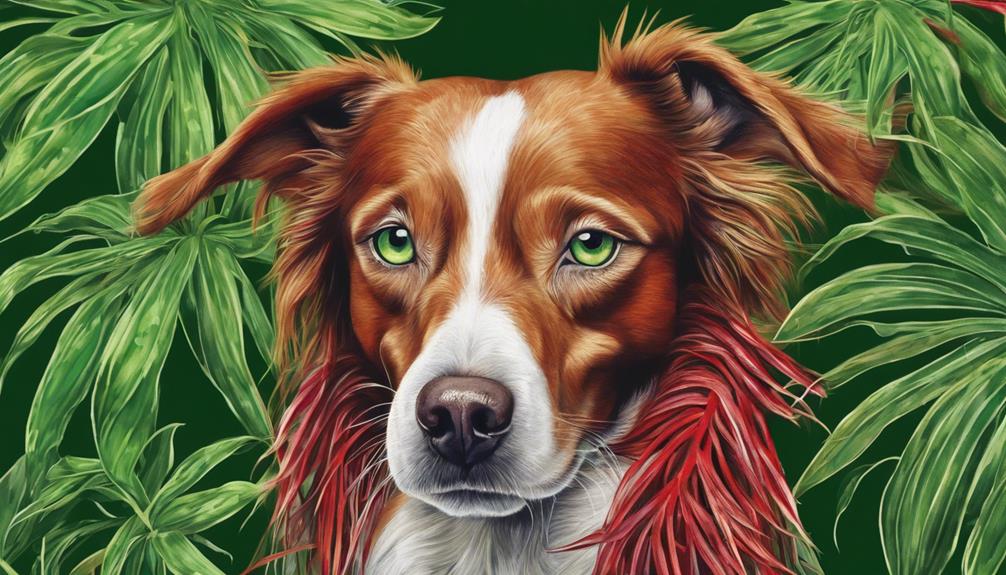
Cordyline plants, like Ti or Hawaiian Ti, are dangerous for dogs due to toxic compounds such as saponins found in all parts. Symptoms of ingestion include vomiting, weakness, and dilated pupils. If toxicity is suspected, induce vomiting, administer activated charcoal, and seek prompt veterinary care. Diagnosing poisoning involves physical exams, tests, and x-rays. Treatments include medication, fluid therapy, and close monitoring. Berries, leaves, and roots carry varying poison levels. Keep pets away from these plants. Consult a vet immediately if ingestion occurs. Veterinary care is essential for managing cordyline toxicity in dogs effectively. Discover more about protecting your furry friends.
Key Takeaways
- Cordyline plant is toxic to dogs due to saponins in all parts.
- Symptoms include vomiting, weakness, and dilated pupils.
- Emergency actions include inducing vomiting and seeking vet care.
- Prompt veterinary diagnosis and treatment are crucial.
- Keep Cordyline plants out of reach to prevent toxicity.
Cordyline Plant Overview
Investigating the harmful nature of the Cordyline plant reveals its potential dangers to dogs. The Cordyline plant, also known as Ti plant or Hawaiian Ti, is a common decorative plant found in many households and gardens. This plant contains toxic compounds, such as saponins, in all its parts, including the berries and roots. These compounds can be harmful to our canine companions if ingested. Dogs may experience symptoms like loss of muscle control, weakness, and gastrointestinal issues if they consume any part of the Cordyline plant. It's vital for pet owners to be aware of the potential dangers this plant poses to their furry friends.
As responsible pet owners, it's important to make sure that our dogs don't have access to the Cordyline plant to prevent accidental ingestion. By being vigilant and keeping our pets away from this toxic plant, we can protect them from experiencing harmful effects on their health. Remember, prevention is essential when it comes to keeping our furry friends safe from toxic plants like the Cordyline.
Common Symptoms of Toxicity

What're the common symptoms of toxicity in dogs exposed to cordyline plants? Dogs can show various signs of toxicity if they ingest parts of the cordyline plant. Some common symptoms include vomiting, weakness, loss of muscle control, and dilated pupils.
These signs can occur immediately or may be delayed, depending on the amount ingested. The toxic compounds present in cordyline, such as saponins and glycosides, are responsible for these harmful effects on dogs. Saponins and glycosides can lead to serious health issues in our canine friends, so it's essential to be aware of these symptoms if your dog has been near or ingested a cordyline plant.
If you notice any of these signs or suspect cordyline toxicity, seek immediate veterinary attention. Remember, prompt diagnosis and proper treatment are crucial for the recovery of dogs exposed to cordyline toxicity. Keep a close eye on your furry companion and act promptly if you suspect any issues related to plants toxic to dogs.
Emergency Actions to Take
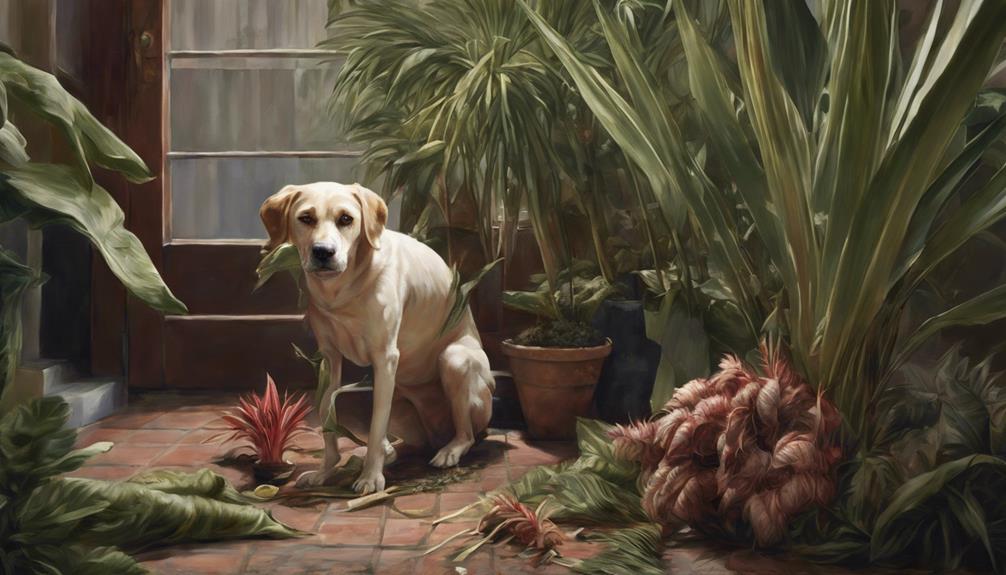
After observing symptoms of cordyline toxicity in dogs, immediate actions can include inducing vomiting to expel the toxic plant material. Administering activated charcoal can help prevent further absorption of toxins. It's important to seek veterinary care promptly. Intravenous fluids might be necessary to flush out the toxins and rehydrate your dog. These steps can aid in the speedy recovery of your pet.
When dealing with a potential cordyline poisoning, remember that quick action is key. Inducing vomiting and giving activated charcoal can limit the harm caused by the toxins. Ensuring your dog receives proper hydration through intravenous fluids will support their healing process. By acting swiftly and decisively, you can increase the chances of a positive outcome for your furry friend. Remember, in emergencies like these, always consult a professional for guidance.
Diagnosing Cordyline Poisoning

To diagnose cordyline poisoning in dogs, veterinarians conduct a thorough physical examination to assess the dog's health parameters. Diagnostic tests such as urine, stool samples, and blood tests may be necessary to confirm cordyline ingestion. X-ray imaging can help detect any tummy blockages caused by ingested plant material in cordyline poisoning cases. Symptoms of cordyline poisoning in dogs may include vomiting blood and weakness, indicating the severity of the toxicity. Here is a table summarizing the diagnostic methods used in cordyline poisoning cases:
| Diagnostic Method | Description |
|---|---|
| Physical Examination | Assess dog's overall health and look for symptoms. |
| Urine Sample Analysis | Check for presence of toxins from ingested plants. |
| Blood Tests | Evaluate blood parameters for signs of toxicity. |
These methods help veterinarians confirm cordyline ingestion and determine the appropriate treatment for the affected dog.
Treatment Options Available

When a dog ingests cordyline and shows symptoms of toxicity, treatment options include:
- Giving medication to counteract the poison
- Providing fluid therapy to flush out toxins and rehydrate the pet
- Closely monitoring essential signs to guarantee improvement
These steps are pivotal in managing the effects of cordyline poisoning and supporting the dog's recovery.
It's essential to seek immediate veterinary care for proper diagnosis and treatment to increase the chances of a successful outcome.
Medication for Poisoning
In treating cordyline toxicity in dogs, activated charcoal may be administered to prevent further absorption of toxins. This helps to bind the toxins in the stomach and intestines, reducing their harmful effects.
Additionally, intravenous (IV) fluids are often given to dogs who've ingested cordyline. These fluids help flush out the toxins from the body and keep the dog hydrated.
Antibiotics may also be prescribed to prevent any infections that could arise from cordyline poisoning.
Moreover, medications like antacids or omeprazole can be used to alleviate stomach issues that may occur due to cordyline toxicity.
Fluid Therapy Options
Utilizing intravenous fluid therapy plays an essential role in supporting dogs affected by cordyline toxicity, aiding in toxin elimination and rehydration. When dealing with cordyline poisoning, administering IV fluids is essential to help flush out the toxins from the body and maintain proper hydration levels. IV fluids not only support organ function but also assist in eliminating toxic substances effectively. By providing fluids intravenously, veterinarians can precisely control the volume and rate of fluid delivery, ensuring the dog receives the necessary support for recovery. Proper fluid therapy helps in maintaining blood pressure, electrolyte balance, and hydration levels, all of which are crucial in the treatment of cordyline toxicity.
| Fluid Therapy Benefits |
|---|
| Supports toxin elimination |
| Aids in rehydration |
| Maintains organ function |
| Controls fluid volume and rate |
| Essential for recovery process |
Monitoring Vital Signs
Evaluating essential signs in dogs affected by cordyline toxicity is pivotal for determining the severity of the poisoning and deciding necessary treatment interventions. Monitoring critical signs such as heart rate, respiratory rate, and temperature is essential in gauging the dog's condition.
Changes in these parameters, along with symptoms like dilated pupils and loss of muscle control, can indicate the seriousness of the toxicity. Veterinarians rely on these signs to measure the effectiveness of treatments and the overall well-being of the dog.
Close observation of important signs guides the treatment plan, ensuring appropriate actions are taken for the dog's recovery. Any abnormalities in essential signs may prompt additional interventions or adjustments to the treatment protocol, emphasizing the importance of continuous monitoring for the dog's health.
Preventing Cordyline Ingestion

To prevent cordyline ingestion in dogs, it's essential to keep these plants out of their reach. Educate yourself on the symptoms of cordyline toxicity to recognize any potential issues early on.
Regularly inspect your surroundings to guarantee the safety of your pets and promptly seek veterinary care if ingestion is suspected.
Dangers of Ingestion
To prevent cordyline ingestion in dogs, it is important for pet owners to be aware of the toxic nature of all parts of the plant and take necessary precautions. Dogs can suffer from cordyline poisoning if they ingest any part of the plant, such as the berries, leaves, or roots. To highlight the dangers of ingestion, consider the following table:
| Part of the Plant | Concentration of Poison |
|---|---|
| Berries | High |
| Leaves | Moderate |
| Roots | High |
Understanding the toxicity levels in different parts of the cordyline plant can help pet owners recognize the seriousness of ingestion. By being informed and vigilant, we can protect our furry friends from the harmful effects of cordyline poisoning.
Safety Measures for Pets
Let's take the necessary steps to safeguard our pets by implementing practical safety measures to prevent cordyline ingestion.
To guarantee your furry friends' well-being, keep cordyline fruticosa plants out of their reach.
Educate yourself on the toxicity levels of these plants for pets.
Consider getting pet insurance to cover emergencies like vomiting blood due to cordyline ingestion.
If you suspect your pet has ingested cordyline, seek veterinary care promptly.
Regularly check your surroundings for cordyline plants to maintain a safe environment for your pets.
Importance of Veterinary Consultation
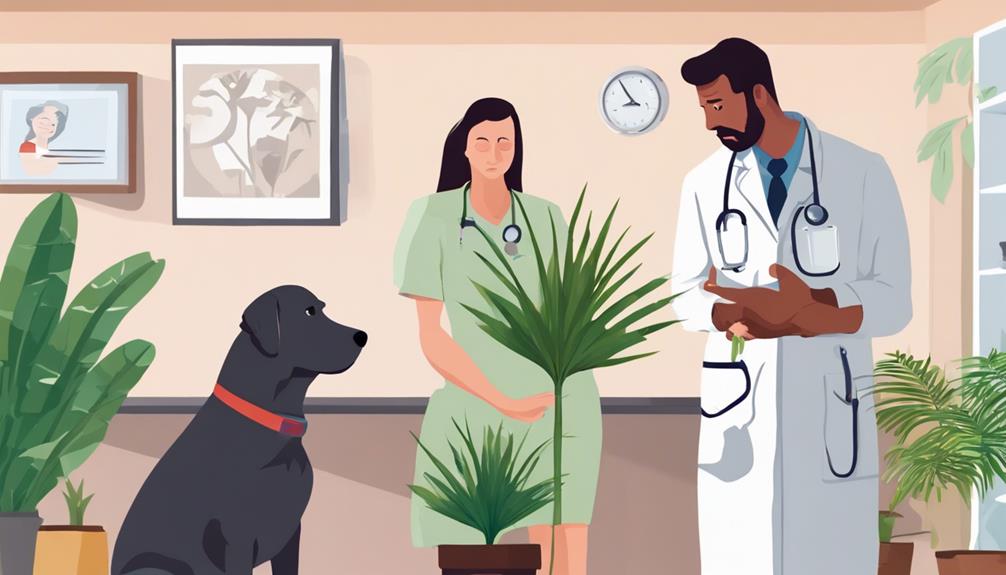
Seeking veterinary consultation promptly is essential when dealing with suspected cordyline toxicity in dogs. When it comes to your furry friend's health, timely action can make a significant difference. Here's why veterinary consultation is pivotal:
- Professional Assessment: Veterinarians have the expertise to evaluate the severity of the situation. They can determine the best course of action to help your dog recover.
- Tailored Treatment: Through veterinary consultation, your pet can receive personalized care. This tailored approach can address specific symptoms and mitigate the effects of cordyline toxicity.
- Prevention of Complications: Acting quickly by consulting a veterinarian can prevent the development of serious complications. Immediate intervention increases the likelihood of a successful recovery for your canine companion.
Frequently Asked Questions
Can Dogs Chew on Ti Leaves?
Yes, dogs shouldn't chew on ti leaves as they're toxic to them. Ingesting ti leaves can cause symptoms like vomiting, diarrhea, and abdominal pain in dogs. The toxic compounds in ti leaves, such as saponins, can lead to serious health issues.
If you suspect your dog has chewed on ti leaves, seek veterinary care immediately for evaluation and treatment. Keep ti plants out of reach of pets to prevent accidental ingestion and toxicity.
Is Cordyline Red Sister Toxic?
Yes, Cordyline Red Sister is toxic to dogs due to saponins present in all parts of the plant. Ingestion can cause vomiting, diarrhea, weakness, and loss of muscle control in dogs. The berries and roots are especially harmful, containing concentrated poison.
Immediate veterinary care is essential if ingestion occurs to avoid severe complications. Treatments may involve induced vomiting, activated charcoal, IV fluids, and organ failure medication.
Is Cordyline Toxic to Humans?
Yes, cordyline plants are harmful to humans. Ingesting parts of the cordyline plant can cause mild symptoms like stomach upset in humans.
The toxic compounds in cordyline affect humans differently than they do dogs. It's important for pet owners to know about cordyline toxicity specifically concerning their dogs.
While cordyline toxicity is a concern for pets, it's not a significant health issue for humans.
Are Cabbage Palms Poisonous to Dogs?
Cabbage palms, or Cordyline plants, are toxic to dogs. Ingesting any part of the plant can cause symptoms like weakness and muscle control loss. Saponins and glycosides are the compounds responsible for this toxicity.
Immediate veterinary attention is vital if ingestion occurs. Symptoms may include vomiting blood, weakness, and abdominal pain. It's important to keep these plants away from pets to prevent any accidental ingestion and potential harm.
Conclusion
To wrap up, it's vital to keep cordyline plants away from your furry friends to prevent potential toxicity. If ingestion occurs, seek immediate veterinary assistance.
Remember, the consequences of cordyline poisoning can be severe, so it's important to take preventative measures seriously. Let's guarantee our pets stay safe and healthy by being vigilant about the plants they come into contact with.
After all, a healthy pet is a happy pet!
Dana is our Lead Content Writer, bringing a wealth of knowledge and expertise to our team. With a background deeply rooted in animal studies and a profound love for all creatures, Dana is dedicated to crafting engaging and informative content that resonates with our audience. With Dana at the helm, you can trust that our content is accurate and engaging, catering to the diverse interests of animal enthusiasts everywhere.
-

 Vetted1 month ago
Vetted1 month ago15 Best Cat Foods for Managing Hyperthyroidism – Vet Approved and Feline Friendly
-

 Cats7 months ago
Cats7 months agoTop 5 Cat Breeders in Arkansas: A Guide
-

 Animal Facts1 month ago
Animal Facts1 month agoSpring Animals: A Guide to Seasonal Wildlife
-

 Vetted1 month ago
Vetted1 month ago15 Best Fresh Dog Food Delivery Services for Your Pup's Health and Happiness
-

 Rabbits2 months ago
Rabbits2 months agoExploring Rabbit Holes: What Do They Look Like?
-

 Fish2 months ago
Fish2 months agoKeeping Your Sucker Fish Thriving at Home
-

 Pets2 months ago
Pets2 months agoLatest Pet Statistics in US – Trends & Insights in 2024
-

 Vetted1 month ago
Vetted1 month ago15 Best Dog Foods for Kidney Disease – Expert Recommendations for Your Pet's Health



















